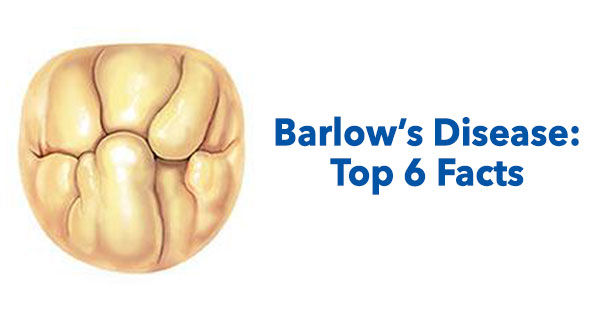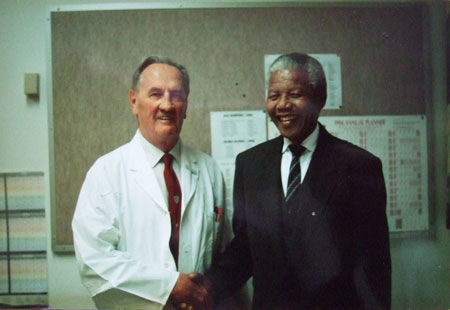Barlow's Mitral Valve Disease: What Should You Know?
Written By: Adam Pick, Patient Advocate, Author & Website Founder
Medical Expert: David Adams, MD, Mount Sinai Hospital
Page Last Updated: May 13, 2025
You – or someone you love - may have been recently diagnosed with Barlow’s Mitral Valve Disease. That said, it's very common to have questions like:
- “What is Barlow’s disease?”
- “What causes Barlow's syndrome?”
- “How can it be treated?”
- “Why is it called Barlow’s disease?”
To help you learn more about this unique type of mitral valve disorder, here are 6 really important facts about Barlow’s disease.

Fact #1: What is Barlow’s Mitral Valve Disease?
According to the Cleveland Clinic, Barlow’s Mitral Valve Disease is a degenerative mitral valve disease that causes blood to leak back into your heart’s left atrium, which is known as mitral regurgitation, or a leaky heart valve.
The Cleveland Clinic notes that Barlow’s Mitral Valve Disease is characterized by a large mitral valve with thickening and “redundant” (not needed) leaflet tissue that causes the valve to appear swollen (as shown in the image above).
When your heart is working properly, your mitral valve closes during contraction and prevents blood from flowing back into your heart. But as the Mayo Clinic describes, in some people with Mitral Valve Prolapse, or MVP, one or both of the mitral valve leaflets – have extra tissue that bulges into the left atrium each time the heart contracts.
This swelling of the valve flaps cause them to close unevenly, so they prolapse into the left atrium – like a parachute – during the heart's contraction. The heart’s structure and the effect of Barlow’s Mitral Valve Disease is shown in the image from the American Heart Association below.
The American Heart Association notes that Barlow’s Mitral Valve Disease is also called click-murmur syndrome (you’ll find out why soon), and floppy valve syndrome. According to the medical resource, MedicineNet, MVP is a common heart valve abnormality affecting 5-10% of the world’s population.
According to the Mayo Clinic, MVP and Barlow’s Mitral Valve Disease can develop in any person at any age and can be genetic.
Fact #2: What are the Symptoms of Barlow Syndrome?
According to the American Heart Association, the most common cause of Barlow’s Syndrome is abnormally stretchy valve leaflets. A person can be born with the risk of developing MVP, or it can be caused by an issue such as a connective tissue diseases (e.g. Marfan’s syndrome).
So what symptoms are there?
According to the Mayo Clinic, many people with Barlow’s disease never have symptoms. They tend to be mild and develop gradually, but may include:
- A racing or irregular heartbeat (arrhythmia)
- Dizziness or lightheadedness
- Difficulty breathing or shortness of breath
- Fatigue
- Chest pain
So, if there are only mild symptoms – or even no symptoms – how is Barlow’s or mitral valve prolapsed diagnosed? Remember how another name for Barlow’s Mitral Valve Disease is click-murmur syndrome?
Through a stethoscope, your doctor may hear a clicking sound as the valve’s leaflets billow out, followed by a murmur from blood whooshing back into the atrium. These two sounds can mean you have mitral valve prolapse.
According to the Mayo Clinic, serious symptoms of mitral valve prolapse tend to occur most often in men over 50.
Fact #3: Barlow’s May or May Not Need To Be Treated
According to the Mayo Clinic, MVP is most often not life-threatening and doesn't require treatment or changes in lifestyle. However, if Barlow’s Mitral Valve Disease has led to significant regurgitation, it may require treatment.
According to the American Heart Association, people with an abnormal mitral valve may need mitral valve repair or mitral valve replacement if: Your symptoms or your heart function are getting worse, or if your heart’s left ventricle is enlarged.
Remember, MVP rarely becomes a highly serious condition requiring heart valve surgery. However, the American Heart Association notes that in the most serious cases, MVP can cause arrhythmias (e.g. atrial fibrillation) that may become life-threatening. And if Barlow’s Mitral Valve Disease causes significant valve leakage, it can lead to serious complications like stroke. According to the Mayo Clinic, you could also develop a heart valve infection, known as endocarditis.
Fact #4: Mitral Valves Can Be Repaired or Replaced
During a mitral valve repair operation, your mitral valve can be reconstructed to ensure proper blood flow through the heart. Mitral valve repair procedures are have several advantages compared to mitral valve replacement operations including freedom from re-operation, longer durability, no use of anti-coagulants (e.g. Coumadin) and a return to normal life expectancy.
That said, mitral valve repair is often referred to as the “gold standard” for treating mitral valve prolapse and Barlow’s Mitral Valve Disease. According to Columbia University Surgery, it is nearly 100% that a leaking mitral valve can be successfully repaired. After mitral valve repair, 95% of patients are free of re-operation at 10 years, and this statistic is similar at 20 years.
Here is a patient success story of Sophie Marsh, an asymptomatic Barlow's disease patient, who had mitral valve repair surgery performed by Dr. David Adams at The Mount Sinai Hospital.
There are situations in which the patient’s mitral valve can not be repaired. In those situations a mitral valve replacement is performed. During mitral valve replacement, this typically open-heart operation usually takes between three to five hours, during which the surgeon removes the diseased mitral valve and replaces it with a mechanical heart valve replacement or a tissue heart valve replacement.
Transcatheter Mitral Valve Replacement (TMVR) devices are also now in feasibility studies and clinical trials. These TMVR procedures do not require an incision to the patient's chest or sternum to be on the heart-lung machine and, in some cases not required to be on general anesthesia.
Fact #5: New Breakthrough Repair Techniques for Barlow's
There are new transcatheter approaches for mitral valve repair which do not require an incision to the patient's sternum or ribs. For example, the MitraClip – available for certain patient populations – is an FDA-approved trans-catheter mitral valve repair device that “clips” the malfunctioning leaflets together in an effort to prevent mitral regurgitation.
According to the Cleveland Clinic, their cardiothoracic surgeons are now using minimally-invasive robotic mitral valve repair using NeoChords on a regular basis. Going back a decade, their doctors began exploring how to improve on techniques for surgical repair of Barlow’s Mitral Valve Disease. Their approach treats the heart’s chords while leaving the leaflets intact.
Since mitral valve leakage can be caused by valve prolapse due to elongated chords, the surgeons replace these with GORE-TEX® neochords during a minimally-invasive, video-assisted robotic technique.
According to the Cleveland Clinic, results of 102 patients with Barlow’s Mitral Valve Disease who underwent the minivally-invasive robotic repair had better outcomes than those who had a sternotomy (open-heart), such as less lengthy average hospital stays and a lower occurrence of post-surgery atrial fibrillation (A-Fib). With surgeons like Dr. Marc Gillinov, minimally invasive repair using robotic assistance is now standard treatment for Barlow’s Mitral Valve Disease at the Cleveland Clinic for most patients.
Fact #6: A Doctor Named Barlow Discovered It!
Barlow’s Mitral Valve Disease is named for the man who “discovered” it. Dr. John Barlow (1924 –2008) was a world-renowned South African cardiologist. In the late 1950s he became Professor of Cardiology in the research unit of Johannesburg Hospital and carried out important studies on cardiac disorders as well as discovering the cause of MVP.
 Dr. John Barlow and Nelson Mandela
Dr. John Barlow and Nelson Mandela
The Mitral Valve Repair Center at The Mount Sinai Hospital notes that the syndrome of click-murmur was first described in the late 1800’s, but it was in the early 1960’s that its association with mitral regurgitation was demonstrated by Dr. Barlow and colleagues.
According to the Royal College of Physicians, Dr. Barlow demonstrated that the click and the murmur were associated with billowing of the mitral valve leaflets which led to mitral regurgitation.
Did you know that, at first, Dr. Barlow’s discovery was controversial and did not win acceptance? In fact, the Royal College of Physicians notes that Barlow’s paper was not accepted for publication in the journal when it was first submitted. Eventually, Dr. Barlow’s full article was published in the October 1963 issue of the American Heart Journal. Here is Dr. Barlow with Nelson Mandela:
I hope these facts about Barlow’s Mitral Valve Disease were helpful.
You May Also Like
Here's more educational information to help you:
- Mitral Valve Disorders
- Mitral Valve Repair: What Should Patients Know?
- Mitral Valve Replacement: Patient Facts
- Patient Success: Phil Can Breathe Freely After MitraClip
References:
https://en.wikipedia.org/wiki/John_Brereton_Barlow
http://munksroll.rcplondon.ac.uk/Biography/Details/6117
https://consultqd.clevelandclinic.org/barlows-disease-treating-the-chords-not-the-leaflets-is-key/
https://www.mayoclinic.org/diseases-conditions/mitral-valve-prolapse/symptoms-causes/syc-20355446
https://www.heart.org/en/health-topics/heart-valve-problems-and-disease/heart-valve-problems-and-causes/problem-mitral-valve-prolapse
https://www.mitralvalverepair.org/barlow-mitral-valve-disease
https://www.medicinenet.com/script/main/art.asp?articlekey=2428
http://columbiasurgery.org/heart/mitral-regurgitation
https://neochord.com/
https://www.goremedical.com/products/cardiovascularpatch



